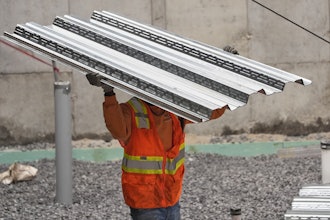
ATLANTIC CITY, N.J. (AP) — The contractor who provided the onion domes for the Taj Mahal casino had to eat $2 million in losses. The contractor who supplied the Carrara marble from Italy ended up filing for personal bankruptcy. The contractor who put in the bathroom partitions had to lay off his brother.
A quarter of a century has passed since Donald Trump refused to pay in full 253 contractors who help build his Taj in Atlantic City. But for many of them, it could have happened yesterday.
"We got next to nothing," says Michael MacLeod, whose 40-person studio made the giant elephant statues at the casino's entrance. "I took a big hit."
After the Taj opened in April 1990, the self-anointed "King of Debt" owed $70 million to contractors employing thousands who built the domes and minarets, put up the glass and drywall, laid the pipes and installed everything from chandeliers to bathroom fixtures. A year later, when the casino collapsed into bankruptcy, those owed the most got only 33 cents in cash for each dollar owed, with promises of another 50 cents later. It took years to get the rest, assuming the companies survived long enough to collect.
Trump spokeswoman Hope Hicks and Trump attorney Alan Garten did not respond to a list of questions about the candidate's Taj dealings.
Marty Rosenberg, former vice president of Atlantic Plate Glass, says the way Trump handled the contractors shows the candidate is shrewd and clever, but Trump won't get his vote.
"If ethics or morality has nothing to do with business," Rosenberg says, "he's a very good businessman."
For the contractors, the first signs of trouble came in February 1990. Regular checks for work completed stopped arriving in the mail.
Rosenberg, who was owed $1.1 million for installing floor-to-ceiling curtain walls of glass, picked up the phone in his Atlantic City office and called one of Trump's men overseeing construction.
"I'll check it out, Marty, and call you right back," the man said. A day later, he got his answer: The money's coming in two weeks.
The check never came.
Five hundred miles away, in Ashtabula, Ohio, Robert Morrison of the Molded Fiber Glass Co. was pressing his workers to finish the domes, minarets and other faux Moorish ornaments in time for an April 2 opening — and worrying about who was going to pay for it all. An invoice sent weeks earlier for $1.4 million still hadn't been paid.
Many contractors didn't know what to think. Trump said he needed to complete audits first to make sure they weren't overcharging; he denied he was in financial trouble. "I have a tremendous amount of cash," he told the Washington Post that March. Desperate for money to pay workers and suppliers, some contractors became easy targets for a new Trump offer: Agree to less than they billed, and he'd pay the lower amounts immediately.
One of the hardest hit was marble supplier John Millar, who was owed $3.9 million.
As he was walking into a meeting with contractors to share strategies, landscaper Herman Caucci asked him what he planned to do: Stick it out, or take cash at a discount?
"I don't know, Herman, I need the money," Caucci recalls Millar responding before the March 1990 meeting. "We could lose everything."
Court documents suggest he got about 30 cents on the dollar over the next year. Millar is deceased. His family wouldn't comment.
The stress was also building at Hastings Pavement, a company supplying paving stones.
Mario Paone, president of Hastings, rarely lost his temper. But he had received only $100,000 of the $1.3 million he had billed Trump.
He exploded one day just as his son, Philip Paone, then 24, walked up to his office door.
"I want my money!" Philip recalls his father screaming into the phone to Trump. "Pay me my money!"
Documents filed with regulators suggest Trump gave Paone about a third of what he was owed over the next year.
Trump managed to open the Boardwalk casino on April 2, 1990, and continued to dismiss rumors that he was in financial trouble, but the truth soon came out.
Over his protests, regulators unsealed a devastating report in August written by Trump's own accountants that showed he had been burning through cash in his personal accounts so fast in the spring that he would have had nothing by end of the year if he didn't take drastic action. The next year, the Trump Taj filed for bankruptcy.
When the casino emerged from Chapter 11, Trump got a contract to manage it. Others caught up in the Taj turmoil didn't fare as well.
Marble man Millar had to lay off workers, shut down his business Avalon Commercial, close many of his retail stores and borrow from friends to make ends meet, according to court documents and Millar's lawyers and former employees. In 1996, he filed for personal bankruptcy.
Morrison's Molded Fiber Glass joined with 47 others in a negotiated settlement with Trump for cash equal to 33 cents of each dollar owed, plus 50 cents in convertible bonds, according to a book by Morrison published in 1994. Strapped for money, some contractors sold the bonds immediately, getting a fraction of what they were worth at maturity.
Morrison wrote off $2 million of the $3 million Trump owed him, according to his book. The company refused to comment.
MacLeod, the elephant sculptor, says his anger has faded.
Giving a slide presentation of his work to an architectural firm two days after Trump swept the New York Republican primary in April, he slipped in two photos — one showing one of the elephants, the other showing Trump's name on the casino marquee in red lights.
"This guy never paid me," MacLeod deadpanned. Everyone laughed.






















